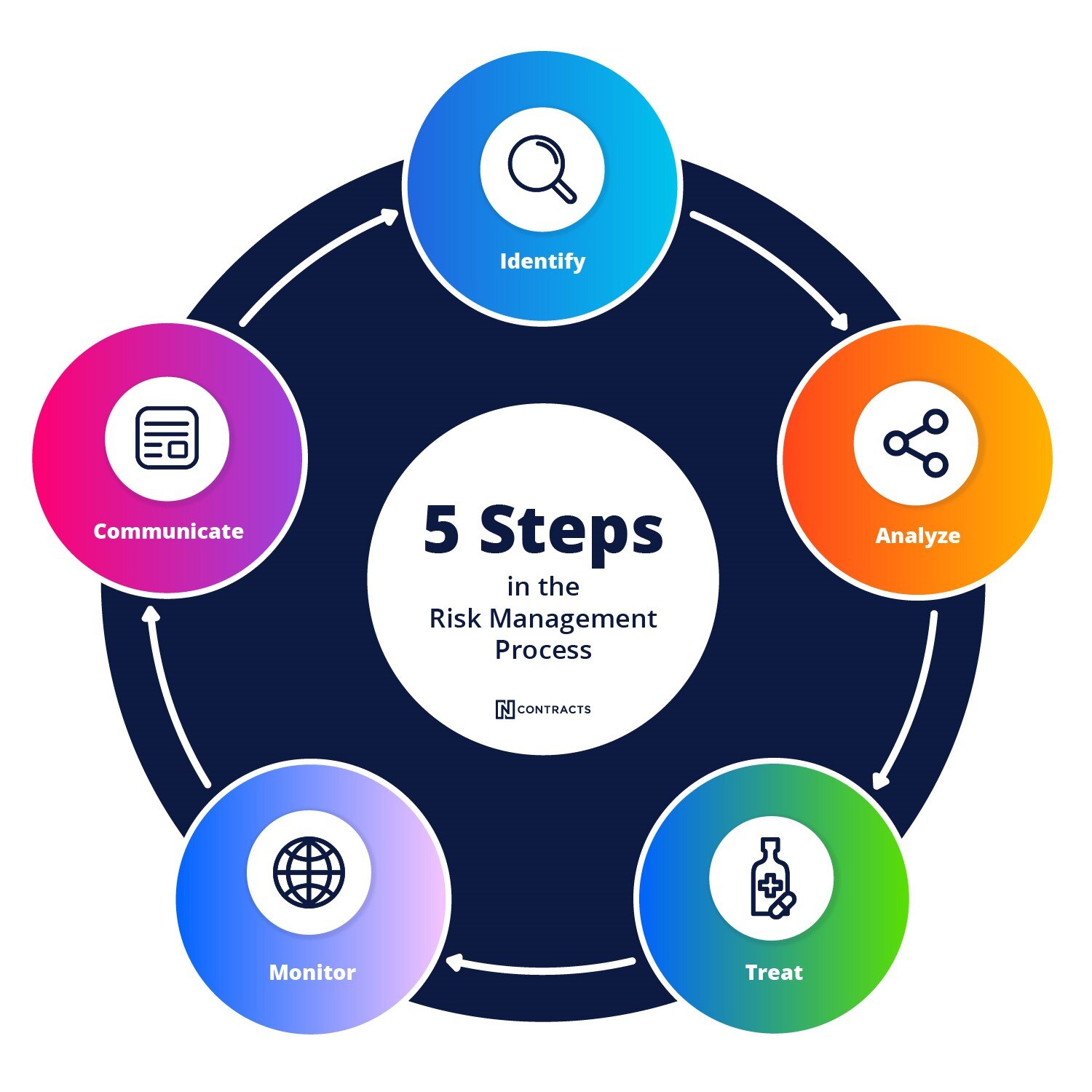A risk management strategy is a plan designed to identify, assess, and address risks that could impact a financial institution’s operations. An effective risk management strategy doesn’t necessarily eliminate risk – it ensures that a financial institution’s risk exposure is aligned with its risk tolerance.
When it comes to risk mitigation strategies, it all comes down to four key responses. You can either:
- Accept the risk
- Avoid the risk
- Mitigate the risk or
- Transfer the risk
Let’s take a closer look at these four risk management strategies.

Risk Avoidance
Risk avoidance is choosing not to engage in actions or activities that could expose your institution to risk. This strategy is often used when the risk of an activity exceeds an institution’s risk tolerance – and either it’s not possible or not worthwhile to try to mitigate the risk. The risk is simply too great.
Financial institutions are experts at risk avoidance. Lenders carefully assess borrowers’ creditworthiness, income, collateral, and other factors before approving loans. If a borrower doesn’t meet the institution’s standards, the applicant is declined because the risk of default is too high. The potential profit of the loan isn’t worth the risk.
An institution might choose not to bank a certain type of customer, such as cannabis-related businesses, because the compliance risk is too high. Or an institution might choose to avoid partnerships with third parties that lack a proven track record.
The downside of risk avoidance is that it can also mean missing out on potential opportunities.
Risk Acceptance
Risk acceptance is a risk management strategy where a financial institution acknowledges a risk and decides not to take any immediate action to mitigate it. An institution may decide to accept the risk when the cost of mitigating the risk outweighs the potential negative impact or when the risk is deemed low enough that it falls within the organization’s risk tolerance. In essence, the organization is willing to "accept" the potential consequences.
For example, a small department might process a handful of transactions manually, which increases the risk of human error. Automating these processes could reduce errors but would require a costly software upgrade and retraining. The institution accepts the risk of occasional manual errors because they are infrequent and have minimal financial impact. It decides the cost of automation isn’t justified at the current transaction volume.
Risk acceptance requires close monitoring to ensure that accepted risks remain within the institution’s risk tolerance over time. Regular reassessments are necessary to ensure that changes in the environment or operations don’t expose the organization to greater risk than initially anticipated.
Risk Mitigation
When it’s not possible to avoid a risk and accepting it doesn’t make sense, risk mitigation is typically the best strategy. Risk mitigation is when an institution tries to limit the impact and likelihood of a risk through controls.
Risk mitigation is particularly important for managing operational risks, such as fraud, data breaches, or system failures. By identifying weaknesses and implementing the appropriate controls, financial institutions can create a more secure environment.
For example, cyber threats are a part of modern banking. You can’t eliminate the risk without going back to recording transactions in a physical ledger. You can’t accept the risk because your institution would quickly fall victim to a cyberattack. The only feasible choice is to mitigate the risk, implementing controls such as firewalls, access control systems, regular software updates and patches, employee security training, and third-party vendor monitoring. These controls reduce the likelihood of a successful cyberattack.
Remember: Risk mitigation and the controls used to implement this strategy won’t necessarily eliminate the risk. Instead, this risk management technique reduces the likelihood and/or impact of a risk event to make it more acceptable.
Risk Transfer
Another example of a risk management strategy is risk transfer. Risk transfer is when a financial institution shifts the risk to another party which then assumes some or all of that risk.
Insurance is a common financial risk management strategy based on risk transfer. Financial institutions buy insurance (e.g., cyber liability, errors and omissions, directors and officers insurance) to transfer the financial risk of data breaches, legal liabilities, or management decisions to an insurance provider. Institutions can also include indemnification provisions in third-party contracts, requiring the third-party to cover losses or damages incurred due to their actions.
Not all risks can be transferred to a third party. For example, a financial institution is always responsible for its compliance risk. Even when outsourcing activities, regulators will hold an institution responsible for a contracted third party’s compliance violations.
Ignoring Risk Is Not a Strategy
The approaches outlined above are all effective examples of risk management strategies – but there is one other common activity that is not an example of a risk management strategy: doing nothing.
Hoping a risk will resolve on its own isn’t strategy. Closing your eyes so you don’t have to look at a risk doesn’t make it disappear. Accepting the status quo without questioning if it still makes sense is risky.
Proactive risk management is key to staying ahead of potential issues and protecting the institution’s bottom line. Ignoring risk leads to greater risk exposure and potential losses down the line.
Related: Why Inertia Creates Risk
Choosing the Best Strategy
Choosing the best risk management strategy is often more art than science. It requires a deep understanding both the risks an institution faces and the broader risk landscape – balancing everything from risk appetite and business objectives to available resources.
There’s no one-size-fits-all answer for selecting a risk strategy – the best strategy for one institution may be entirely wrong for another. And chances are the best strategy isn’t a single strategy. Financial institutions use a combination of these strategies to manage different types of risks simultaneously.
Reputational risk might be managed through a mix of avoidance and mitigation. For example, an institution might choose not to serve industries or clients that carry reputational risks while at the same time mitigating reputation risk with a culture of compliance that promotes ethical behavior.
Selecting the right risk response strategy begins with a thorough risk assessment. Financial institutions need to carefully evaluate the probability of a risk occurring and the potential impact it could have.
Once a risk is identified, the next step is to align it with the institution’s risk tolerance. For example, if a financial institution has a low tolerance for operational disruptions, it might prioritize risk avoidance or mitigation over acceptance. On the other hand, if the risk in question is relatively small or unlikely to occur, and the cost of addressing it is prohibitively high, risk acceptance may be the most pragmatic choice.
Risk transference is attractive when an institution recognizes the need to manage a risk but lacks the capacity or desire to take on the full burden. Transferring risk allows a financial institution to focus on its core competencies while outsourcing specific risks to those better equipped to handle them.
Ultimately, the best risk strategy is one that supports the institution’s broader objectives. It’s about finding a balance – protecting the institution from significant harm while still allowing it to pursue opportunities.
Related: ERM 101: What’s Your FI’s Risk Appetite?
Executing Your Risk Management Strategy
Executing a risk management strategy isn’t a one-time event—it’s an ongoing process that requires commitment, vigilance, and flexibility.
What worked last year or even last quarter may not be the best approach moving forward. Financial institutions need to remain agile, ready to reassess and adjust their strategies as new risks emerge or old risks evolve.
It’s all about following the five-step risk management process:
- Risk Identification: Identify potential risks that could impact the organization's objectives, operations, or reputation.
- Risk Assessment: Analyze and prioritize risks based on their likelihood and potential impact, using both qualitative and quantitative methods.
Related: Expert Q&A: How to Build a Risk Assessment
- Risk Response (or Risk Treatment): Choose the appropriate risk management strategy—avoidance, mitigation, transfer, or acceptance—for each identified risk.
- Risk Monitoring: Continuously monitor risks and evaluate the effectiveness of risk management strategies and controls through regular reviews and audits.
- Review and Adjust: Periodically review the entire risk management process and adjust strategies to address emerging risks or changes in the organization’s environment.

Related: Creating the Perfect Risk Management Plan
Regular risk assessments are essential tools for understanding which risk management strategy to use. They measure how great a risk is and how effectively it is mitigated – critical data when deciding whether to continue avoiding, accepting, mitigating, or transferring risk.
Related: Managing Risks Like An Astronaut
How Ncontracts Can Support Your Risk Management Strategy
Effectively managing risk requires the right tools, and that’s where Ncontracts comes in. Our comprehensive suite of integrated risk management solutions delivers the insights and assistance financial institutions need to choose and execute on the right risk management strategies.
Nrisk helps financial institutions determine the best risk management strategy, guiding them through every step of the risk management process, helping identify, assess, mitigate, monitor, and communicate risk.
Comprehensive risk assessments that evaluate the likelihood and impact of each identified risk. Not sure where to begin? Model risk assessments give you jumping off point you need and can be tailored to your institution’s needs. They suggest risks to investigate and show you which factors to consider.
Want to see where your risk exposure aligns with your risk tolerance? Heat maps show you where you have excessive risk, helping you decide which risk management strategy is most appropriate. Nrisk empowers institutions to confidently choose whether to avoid, mitigate, transfer, or accept each risk based on the most up-to-date information.
And because Nrisk standardizes how your institution looks at risk, it ensures your institution has accurate, apples-to-apples assessments that make it easy to understand and communicate risk and your decisions about risk management strategies.
Do you have the tools you need to make smart risk management strategy decisions? Demo Nrisk and see how Ncontracts can help you optimize your risk management strategy.


